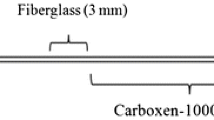Abstract
Monoclonal antibodies are a group of commonly used therapeutics, whose occupational health risk is still discussed controversially. The long-term low-dose exposure side effects are insufficiently evaluated; hence, discussions are often based on a theoretical level or extrapolating side effects from therapeutic dosages. While some research groups recommend applying the precautionary principle for monoclonal antibodies, others consider the exposure risk too low for measures taken towards occupational health and safety. However, both groups agree that airborne monoclonal antibodies have the biggest risk potential. Therefore, we developed a peptide-based analytical method for occupational exposure monitoring of airborne monoclonal antibodies. The method will allow collecting data about the occupational exposure to monoclonal antibodies. Thus, the mean daily intake for personnel in pharmacies and the pharmaceutical industry can be determined for the first time and will help to substantiate the risk assessment by relevant data. The introduced monitoring method includes air sampling, sample preparation and detection by liquid chromatography coupled with high-resolution mass spectrometry of individual monoclonal antibodies as well as sum parameter. For method development and validation, a chimeric (rituximab), humanised (trastuzumab) and a fully humanised (daratumumab) monoclonal antibody are used. A limit of detection between 1 μg per sample for daratumumab and 25 μg per sample for the collective peptide is achieved.

Demonstration of the analytical workflow, from the release of monoclonal antibodies to the detection as single substances as well as sum parameter.




Similar content being viewed by others
References
Beck A, Sanglier-Cianferani S, Van Dorsselaer A. Biosimilar, biobetter, and next generation antibody characterization by mass spectrometry. Anal Chem. 2012;84(11):4637–46. https://doi.org/10.1021/ac3002885.
Rodgers KR, Chou RC. Therapeutic monoclonal antibodies and derivatives: historical perspectives and future directions. Biotechnol Adv. 2016;34(6):1149–58. https://doi.org/10.1016/j.biotechadv.2016.07.004.
Brian A. Baldo, (2017) Safety of biologics therapy: monoclonal antibodies, cytokines, fusion proteins, hormones, enzymes, coagulation proteins, vaccines, botulinum toxins, 1st Edition, Springer, 2016, Print Book ISBN: 978-3-319-30470-0, e-Book ISBN 978-3-319-30472-4. Drug Saf 40 (10):933–934.
Weiner GJ. Building better monoclonal antibody-based therapeutics. Nat Rev Cancer. 2015;15(6):361–70. https://doi.org/10.1038/nrc3930.
Lindsley CW. New 2016 data and statistics for global pharmaceutical products and projections through 2017. ACS Chem Neurosci. 2017;8(8):1635–6. https://doi.org/10.1021/acschemneuro.7b00253.
Beck A, Goetsch L, Dumontet C, Corvaia N. Strategies and challenges for the next generation of antibody drug conjugates. Nat Rev Drug Discov. 2017;16(5):315–37. https://doi.org/10.1038/nrd.2016.268.
Carter PJ, Lazar GA. Next generation antibody drugs: pursuit of the high-hanging fruit. Nat Rev Drug Discov. 2017; https://doi.org/10.1038/nrd.2017.227.
Halsen G, Krämer I. Assessing the risk to health care staff from long-term exposure to anticancer drugs—the case of monoclonal antibodies. J Oncol Pharm Pract. 2011;17(1):68–80. https://doi.org/10.1177/1078155210376847.
King J, Alexander M, Byrne J, MacMillan K, Mollo A, Kirsa S, et al. A review of the evidence for occupational exposure risks to novel anticancer agents—a focus on monoclonal antibodies. J Oncol Pharm Pract. 2016;22(1):121–34. https://doi.org/10.1177/1078155214550729.
Langford S, Fradgley S, Evans M, Blanks C. Assessing the risk of handling monoclonal antibodies. Hosp Pharm. 2008;15:60–4.
Alexander M, King J, Bajel A, Doecke C, Fox P, Lingaratnam S, et al. Australian consensus guidelines for the safe handling of monoclonal antibodies for cancer treatment by healthcare personnel. Intern Med J. 2014;44(10):1018–26. https://doi.org/10.1111/imj.12564.
Bos JD, Meinardi M. The 500 Dalton rule for the skin penetration of chemical compounds and drugs. Exp Dermatol. 2000;9(3):165–9. https://doi.org/10.1034/j.1600-0625.2000.009003165.x.
Ferri N, Bellosta S, Baldessin L, Boccia D, Racagni G, Corsini A. Pharmacokinetics interactions of monoclonal antibodies. Pharmacol Res. 2016;111:592–9. https://doi.org/10.1016/j.phrs.2016.07.015.
Fellner RC, Terryah ST, Tarran R. Inhaled protein/peptide-based therapies for respiratory disease. Mol Cell Pediatr. 2016;3(1):16. https://doi.org/10.1186/s40348-016-0044-8.
Maillet A, Congy-Jolivet N, Le Guellec S, Vecellio L, Hamard S, Courty Y, et al. Aerodynamical, immunological and pharmacological properties of the anticancer antibody cetuximab. Pharm Res. 2008;25(6):1318–26. https://doi.org/10.1007/s11095-007-9481-3.
Kaestli LZ, Fonzo-Christe C, Bonfillon C, Desmeules J, Bonnabry P. Development of a standardised method to recommend protective measures to handle hazardous drugs in hospitals. Eur J Hosp Pharm-Sci Pract. 2013;20(2):100–5. https://doi.org/10.1136/ejhpharm-2012-000222.
Halsen G, Krämer I. Bewertung monoklonaler Antikörper zum Schutz Beschäftigter. Berufsgenossenschaft für Gesundheitsdienst und Wohlfahrtspflege. Germany: Hamburg; 2008.
Promega. Sequencing grade modified trypsin: product information. 2016 https://www.promega.com/-/media/files/resources/protocols/product-information-sheets/n/sequencing-grade-modified-trypsin-protocol.pdf?la=en. Accessed 28.11.17.
Mandel J. The statistical analysis of experimental data. Washington: Wiley; 1964.
Sandra K, Vandenheede I, Sandra P. Modern chromatographic and mass spectrometric techniques for protein biopharmaceutical characterization. J Chromatogr A. 2014;1335:81–103. https://doi.org/10.1016/j.chroma.2013.11.057.
van den Broek I, Niessen WMA, van Dongen WD. Bioanalytical LC-MS/MS of protein-based biopharmaceuticals. J Chromatogr B. 2013;929:161–79. https://doi.org/10.1016/j.jchromb.2013.04.030.
Beck A, Wagner-Rousset E, Ayoub D, Van Dorsselaer A, Sanglier-Cianferani S. Characterization of therapeutic antibodies and related products. Anal Chem. 2013;85(2):715–36. https://doi.org/10.1021/ac3032355.
Leurs U, Mistarz UH, Rand KD. Getting to the core of protein pharmaceuticals—comprehensive structure analysis by mass spectrometry. Eur J Pharm Biopharm. 2015;93:95–109. https://doi.org/10.1016/j.ejpb.2015.03.012.
Nowak C, Cheung J, Dellatore S, Katiyar A, Bhat R, Sun J, Ponniah G, Neill A, Mason B, Beck A, Liu H. Forced degradation of recombinant monoclonal antibodies: a practical guide. mAbs. 2017; 1–14. https://doi.org/10.1080/19420862.2017.1368602.
Schey KL, Finley EL. Identification of peptide oxidation by tandem mass spectrometry. Accounts Chem Res. 2000;33(5):299–306. https://doi.org/10.1021/ar9800744.
Joubert MK, Luo QZ, Nashed-Samuel Y, Wypych J, Narhi LO. Classification and characterization of therapeutic antibody aggregates. J Biol Chem. 2011;286(28):25118–33. https://doi.org/10.1074/jbc.M110.160457.
Wu HX, Kroe-Barrett R, Singh S, Robinson AS, Roberts CJ. Competing aggregation pathways for monoclonal antibodies. FEBS Lett. 2014;588(6):936–41. https://doi.org/10.1016/j.febslet.2014.01.051.
Paul-Ehrlich-Institut. Monoklonale Antikörper. 2017 http://www.pei.de/DE/arzneimittel/immunglobuline-monoklonale-antikoerper/monoklonale-antikoerper/monoklonale-antikoerper-node.html. Accessed 28.11.17.
Wei T, Kaewtathip S, Shing K. Buffer effect on protein adsorption at liquid/solid interface. J Phys Chem C. 2009;113(6):2053–62. https://doi.org/10.1021/jp806586n.
ISPE. Good practice guide: assessing the particulate containment performance of pharmaceutical equipment. 2nd ed. Bethesda: International Society for Pharmaceutical Engineering; 2012.
Acknowledgements
We thank Agilent Technologies and especially Dr. Bita Kolahgar for providing the HPLC-QTOF system and the technical support.
Author information
Authors and Affiliations
Corresponding author
Ethics declarations
Conflict of interest
The authors declare they have no conflict of interest.
Electronic supplementary material
ESM 1
(DOCX 67 kb)
Rights and permissions
About this article
Cite this article
Reinders, L.M.H., Klassen, M.D., Jaeger, M. et al. Development of an analytical method to assess the occupational health risk of therapeutic monoclonal antibodies using LC-HRMS. Anal Bioanal Chem 410, 2829–2836 (2018). https://doi.org/10.1007/s00216-018-0966-1
Received:
Revised:
Accepted:
Published:
Issue Date:
DOI: https://doi.org/10.1007/s00216-018-0966-1




